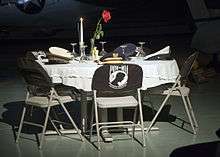Missing man table
The Missing Man Table, also known as the Fallen Comrade Table,[1] is a place of honor, set up in military dining facilities of the U.S. armed forces and during occasions such as service branch birthday balls, in memory of fallen, missing, or imprisoned military service-members.[2] The table serves as the focal point of ceremonial remembrance, originally growing out of US concern of the Vietnam War POW/MIA issue.[3][4]
Observance
Beyond permanent displays in dining facilities, the missing man table is traditionally part of military dining-in ceremonies and service balls. In recent years, the ceremony has been frequently performed in conjunction with Veterans Day and Memorial Day services.[5][6][7] When presented in a dining-in or service ball, a narration given to the audience explains the symbolism of each item. The practice of the missing man table has evolved over time and is not currently governed by any US Department of Defense or service-specific guidance.
Symbolism

The listed items are considered traditional. Some commands and units may place headcovers or other items at the place setting as well.[8]
- Table: set for one, is small, symbolizing the frailty of one isolated prisoner. The table is usually set close to, or within sight of, the entrance to the dining room. For large events of the Missing Man Table is set for six places: members of the five armed services (Army, Navy, Marine Corps, Air Force, and Coast Guard) and a sixth place setting reminiscent of the civilians who died during service alongside the armed forces or missing during armed conflict.[9] Table is round to represent everlasting concern on the part of the survivors for their missing loved ones.[10]
- Tablecloth is white, symbolic of the purity of their intentions to respond to their country's call to arms.[11]
- Single red rose in the vase, signifies the blood that many have shed in sacrifice to ensure the freedom of our beloved United States of America. This rose also reminds us of the family and friends of our missing comrades who keep the faith, while awaiting their return.[12]
- The red ribbon (yellow ribbon for Air Force ceremonies) represents the love of our country, which inspired them to answer the nation's call.[13]
- Slice of lemon on the bread plate: represents the bitter fate of the missing.[14]
- Salt sprinkled on the bread plate: symbolic of the countless fallen tears of families as they wait.[14]
- Inverted glass: represents the fact that the missing and fallen cannot partake.
- The Bible represents the spiritual strength and faith to sustain those lost from our country. (The Bible has been removed from several displays at federal facilities due to pressure from the Military Religious Freedom Foundation)[15]
- Lit candle: reminiscent of the light of hope which lives in our hearts to illuminate their way home, away from their captors, to the open arms of a grateful nation.
- Empty chair: the missing and fallen aren't present.[16]
References
- ↑ "West Point - 404". www.usma.edu.
- ↑ Producer, By Larry Shaughnessy, CNN Pentagon. "POW/MIA day brings somber ceremony, one quietly symbolic tradition".
- ↑ "25th Air Force > Home". www.afisr.af.mil.
- ↑ http://www.defense.gov/News/NewsArticle.aspx?ID=55908
- ↑ MARADMIN 020/07 http://www.marinecorpstimes.com/news/2007/04/marine_almar02007_070412/
- ↑ http://www.jackson.army.mil/Leader_Archives/June%2021%20PDFs.pdf%5Bpermanent+dead+link%5D
- ↑ "West Point Army Birthday Celebration".
- ↑ "Archived copy". Archived from the original on 2013-02-24. Retrieved 2013-03-03.
- ↑ Bannerman, Stacy (2006). When the war came home: the inside story of reservists and the families they leave behind. Continuum International Publishing Group. p. 178. ISBN 978-0-8264-1795-4.
- ↑ "404w Page Not Found (DTIC)" (PDF). www.dtic.mil.
- ↑ "Archived copy" (PDF). Archived from the original (PDF) on 2010-12-26. Retrieved 2013-03-03.
- ↑ "Archived copy" (PDF). Archived from the original (PDF) on 2012-04-17. Retrieved 2013-03-03.
- ↑ "The POW/MIA Table: A Place Setting for One, A Table for All - Navy Live". navylive.dodlive.mil.
- 1 2 "Archived copy". Archived from the original on 2013-03-10. Retrieved 2013-03-03.
- ↑ http://www.militaryreligiousfreedom.org/press-releases/2016/TobyhannaArmyDepotPOW_MIA_4-19-16.html
- ↑ "Veterans honored at annual Fort Meade luncheon".
